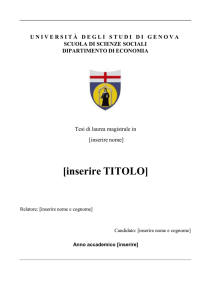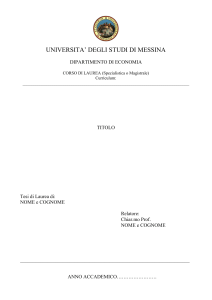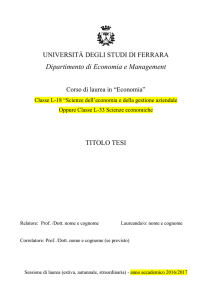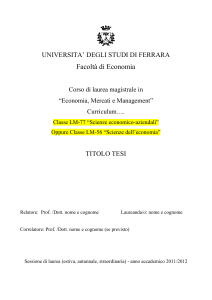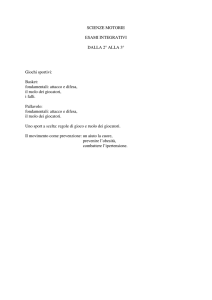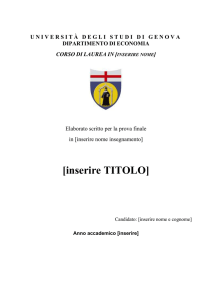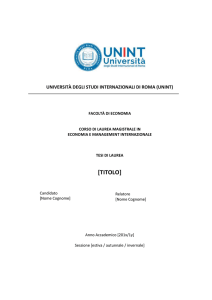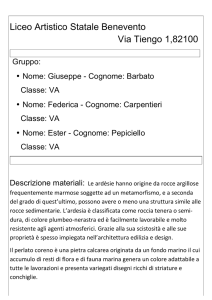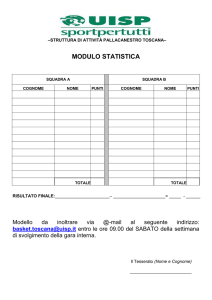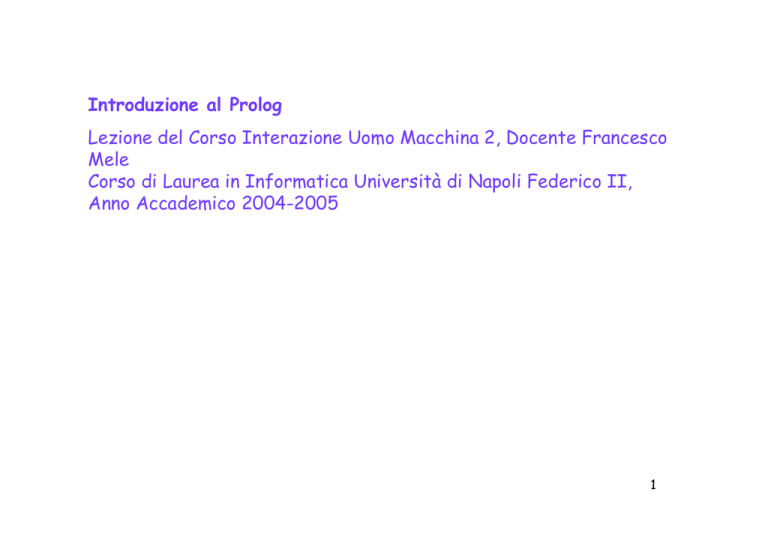
Introduzione al Prolog
Lezione del Corso Interazione Uomo Macchina 2, Docente Francesco
Mele
Corso di Laurea in Informatica Università di Napoli Federico II,
Anno Accademico 2004-2005
1
IL PROLOG - DUE PRINCIPALI INTERPRETAZIONI
Come linguaggio dichiarativo (in un’accezione logica)
è vero che S1 è sorella di S2 se
sorella_di(S1,S2):Esempio di
programma
Prolog
donna(S1),
è vero che S1 è donna e
genitori(P,M,S1),
è vero che P e M sono genitori di S1 e
genitori(P,M,S2).
è vero che P e M sono genitori di S2
Come linguaggio procedurale
sorella_di(S1,S2):donna(S1),
genitori(P,M,S1),
genitori(P,M,S2).
La procedura sorella_di(S1,S2) ha successo
(viene fornito un valore ad S1 e S2) se
hanno successo le procedure donna(S1),
genitori(P,M,S1), genitori(P,M,S2).
Costanti
1- le costanti iniziano per lettera minuscola:
a, b, c, f7, u6, penna, carta, andrea, camilleri,
numeroStudenti, prezzoLibri;
2- gli interi sono costanti:
1,3, 44, 100;
3- le stringhe sono costanti:
'penna', 'il corso delle cose', 'Andrea'
Variabili
Le variabili iniziano con la lettera maiuscola:
X, Y, F1, F2, Testi, Titoli, MarcheProdotti, ListaLibri
Programmi prolog
Un programma Prolog è composto da:
fatti;
regole;
query
Fatti
personaggio(montalbano).
personaggio(maigret).
personaggio('Pepe Carvalho').
scrittore(georges,simenon).
scrittore(andrea,camilleri).
scrittore(manuel,montalban).
libro('Tatuaggio', montalban, 'Universale Economica Feltrinelli').
libro('La gita a Tindari',camilleri,'Sellerio').
libro('Il profumo della notte',camilleri,'Sellerio').
Query 1
| ?- personaggio(X).
X = montalbano ;
X = maigret
| ?-
Unificazione fra la variabile X e le
costante montalbano.
Query 2
Query 3
| ?- scrittore(X,Y).
| ?- scrittore(georges, simenon).
X = georges ,
Y = simenon ;
yes
X = andrea ,
Y = camilleri ;
X = manuel,
Y = montalban
| ?-
| ?-
Query con variabili condivise (shared).
| ?- scrittore(H,X),libro(Titolo, X, Editore).
H = andrea ,
X = camilleri ,
Titolo = 'La gita a Tindari' ,
Editore = 'Sellerio' ;
H = andrea ,
X = camilleri ,
Titolo = 'Il profumo della notte' ,
Editore = 'Sellerio' ;
H = manuel ,
X = montalban ,
Titolo = 'Tatuaggio' ,
Editore = 'Feltrinelli';
Virgola come
congiunzione logica
Database dei fatti
scrittore(georges,simenon).
scrittore(andrea,camilleri).
scrittore(manuel,montalban).
libro('Tatuaggio', montalban, 'Feltrinelli').
libro('La gita a Tindari',camilleri,'Sellerio').
libro('Il profumo della notte',camilleri,'Sellerio').
Regole
Testa della regola
Corpo della regola
Esecuzione
autore_di(Cognome,Titolo):scrittore(Nome,Cognome),
libro(Titolo,Cognome,Editore).
| ?- autore_di(Y,U).
Y = camilleri ,
U = 'La gita a Tindari' ;
Y = camilleri ,
U = 'Il profumo della notte' ;
Y = montalban ,
U = 'Tatuaggio' ;
no
| ?-
Backtacking Prolog (I)
| ?- autore_di(Cognome,Titolo).
Insieme di eventi
Prima di ogni discussione - per efficienza di
programmazione (e non solo) nei programmi
occorre scrivere in ordine prima i fatti e poi
le regole.
1° l’interprete partendo
scrittore(Nome,Cognome).
dall’inizio
del programma a) cerca
fra
i fatti e
autore_di(Cognome,Titolo).
poi tra le regole
e b) trova una
libro(Titolo,simenon,Editore).
regola con una testa dello stesso
tipo della query.
2° l’interprete a) inserisce fra i suoi
obiettivi quello di instanziare
scrittore(Nome, Cognome) b) parte
dall’inizio del programma c) instanzia
Nome= georges Cognome= simenon).
3° continua di dimostare tutte le
condizioni della regola attivita - ma
fallisce la ricerca per
libro(Titolo, simenon, Editor)
scrittore(Nome,Cognome).
Cognome =
simenon
libro(Titolo,simenon,Editore).
/* Inizio programma */
/* Database */
scrittore(georges,simenon).
scrittore(andrea,camilleri).
scrittore(manuel,montalban).
libro('Tatuaggio', montalban, 'Feltrinelli').
libro('La gita a Tindari',camilleri,'Sellerio').
libro('Il profumo della notte',camilleri,'Sellerio').
/* Regole */
autore_di(Cognome,Titolo):scrittore(Nome,Cognome),
libro(Titolo,Cognome,Editore).
/* Fine programma */
Fallimento per Cognome = simenon
Backtacking Prolog (II)
| ?- autore_di(Cognome,Nome).
libro(Titolo,camilleri,Editore).
/* Inizio programma */
/* Database */
scrittore(Nome,simenon).
Cognome=simenon
Cognome=camilleri, scrittore(Nome,Cognome).
Nome=andrea
Titolo= 'La gita a Tindari‘
Editore= ‘Sellerio’
scrittore(georges,simenon).
scrittore(andrea,camilleri).
scrittore(manuel,montalban).
libro('Tatuaggio', montalban, 'Feltrinelli').
libro('La gita a Tindari',camilleri,'Sellerio').
libro('Il profumo della notte',camilleri,'Sellerio').
/* Regole */
autore_di(C,T).
Cogmome=camilleri,
scrittore(Nome,Cognome)
Nome=andrea
.
libro(Titolo,camilleri,Editore).
Titolo= 'La gita a Tindari‘
Editore= ‘Sellerio’
autore_di(Cognome,Titolo):scrittore(Nome,Cognome),
libro(Titolo,Cognome,Editore).
/* Fine programma */
Successo di autore_di(camilleri, 'La gita a Tindari‘)
Fallimento per Cognome = simenon
Indeterminismo del Prolog
WIN PROLOG
c.
f.
b:-a.
a:-b,c,f.
b:-c,f.
| ?- a.
Error 1, Backtrack Stack Full, Trying
b/0
Aborted
XSB PROLOG
c.
f.
b:-a.
a:-b,c,f.
b:-c,f.
| ?- a.
CONFRONTO CON DATABASE (I)
TABELLA GIOCATORE
Id
Nome
Cognome Ruolo
Nazione
FATTI PROLOG (Database Prolog)
1
Zinedine
Zidane
attaccante
Francia
giocatori(1,’Zinedine’, ‘Zidane’, attaccante, ‘Francia’).
2
Roberto
Carlos
terzino
Brasile
giocatori(2,’Roberto’, ‘Carlos’, terzino, ‘Brasile’).
3
Francesco Totti
attaccante
Italia
giocatori(3,’Francesco’, ‘Totti’, attaccante, ‘Italia’).
4
Gianluigi
Italia
giocatori(4,’Gianluigi’, ‘Buffon’, portiere, ‘Italia’).
5
Francesco Toldo
Italia
giocatori(5,’Francesco’, ‘Toldo’, portiere, ‘Italia’).
Buffon portiere
portiere
QUERY SELECT Nome,Cognome
SQL
FROM Tabella_giocatori
WHERE Nazione="Italia";
FORMA
DELLA
RISPOSTA
Nome
Cognome
Francesco Totti
Gianluigi
Buffon
Francesco Toldo
QUERY
PROLOG
?- giocatori(_,X,Y,_,’Italia’).
Oppure (poco usato)
?- giocatori(_,X, Y,_,N), N = ‘Italia’.
X =
FORMA
Y =
DELLA
RISPOSTA
X =
Y =
’Zinedine’ ,
‘Zidane’ ;
’Roberto’ ,
‘Carlos’ ,;
X = ’Francesco’ ,
Y = ‘Totti’ ;
SEGUE
X = ’Gianluigi’ ,
Y = ‘Buffon’
X = ’Francesco’
Y = ‘Toldo’
CONFRONTO CON DATABASE (II)
TABELLA GIOCATORE
FATTI PROLOG (Database giocatori modificato
Id
Nome
1
Zinedine
Zidane
attaccante
Francia
1
giocatori(2,’Roberto’, ‘Carlos’, terzino, ‘Brasile’,1).
2
Roberto
Carlos
terzino
Brasile
1
giocatori(3,’Francesco’, ‘Totti’, attaccante, ‘Italia’,4).
3
Francesco Totti
attaccante
Italia
4
giocatori(4,’Gianluigi’, ‘Buffon’, portiere, ‘Italia’,2).
4
Gianluigi
Italia
2
giocatori(5,’Francesco’, ‘Toldo’, portiere, ‘Italia’,3).
5
Francesco Toldo
Italia
3
TABELLA
SQUADRE
Cognome Ruolo
Nazione
Buffon portiere
portiere
Squadra
giocatori(1,’Zinedine’, ‘Zidane’, attaccante, ‘Francia’,1).
Id
Nome
Città
Nazione
squadre(1, ‘Real Madrid’, ‘Madrid’, ‘Spagna’).
1
Real Madrid
Madrid
Spagna
squadre(2, ‘Juventus’, ‘Torino’, ‘Italia’).
2
Juventus
Torino
Italia
squadre(3, ‘Inter’, ‘Milano’, ‘Italia’).
3
Inter
Milano
Italia
squadre(4, ‘Roma’, ‘Roma’, ‘Italia’).
4
Roma
Roma
Italia
QUERY
SQL
SELECT Giocatori.Nome,
Giocatori.Cognome, Squadre.Nome
FROM Giocatori INNER JOIN
Squadre ON Giocatori.Squadra =
Squadre.Id;
QUERY
PROLOG
?- giocatori(_,X,Y,_,_,Ids), squadre(Ids,N,_,_).
Domanda: se in corrispondenza di …
QUERY
SQL
QUERY
PROLOG
SELECT Giocatori.Nome,
Giocatori.Cognome, Squadre.Nome
FROM Giocatori INNER JOIN Squadre
ON Giocatori.Squadra =
Squadre.Id;GioSquad.Id2=Squadre.Id;
?- giocatori(_,X,Y,_,_,Ids),
squadre(Ids,N,_,_).
allora a quale struttura dei database corrisponde una regola Prolog del tipo:
?
REGOLA
PROLOG
?- squadra_di(X,Y,N):
giocatori(_,X,Y,_,_,Ids),
squadre(Ids,N,_,_).
IL CUT !
% Data base dei fatti
g(a). % Prima soluzione
g(b). % Seconda soluzione
g(c). % Terza soluzione
% Prima modalità di ricerca di soluzioni: va bene la prima soluzione trovata
p1(a):-g(a),messaggio(1),!.
p1(b):-g(a),g(b),messaggio(1),!.
p1(c):-g(a),g(b),g(c),messaggio(1),!.
p1(X):-messaggio(3),fail.
% Seconda modalità di ricerca di soluzioni: esplora tutte le soluzioni
p2(a):-g(a),messaggio(2).
p2(b):-g(a),g(b),messaggio(2).
p2(c):-g(a),g(b),g(c),messaggio(2).
p2(X):-messaggio(4).
% Terzo modalità di ricerca di soluzioni: forza il fallimento per trovare tutte le soluzioni
p3(X):-g(X),write('Soluzione: '),write(X),nl,fail.
p3(X):-messaggio(4).
% Messaggi
messaggio(1):-write('Questa unica soluzione va bene '),nl.
messaggio(2):-write('Forse ci sono altre soluzioni - (digitare ;) '),nl.
messaggio(3):-write('Nessuna soluzione per questo valore'),nl.
messaggio(4):-write('Nessuna altra giustificazione'),nl,fail.
RICERCARE SOLUZIONI E INSERIRLE IN LISTE
% Data
g(c,1).
g(a,4).
g(f,5).
g(b,3).
base dei fatti
% Prima soluzione
% Seconda soluzione
% Terza soluzione
% Quarta soluzione
IL PREDICATO findall
IL PREDICATO setof
in_lista_disordinata1(L):-findall(X,g(X,_),L).
in_lista_disordinata2(L):-findall(J,g(_,J),L).
in_lista_disordinata3(L):-findall(g(X,J),g(X,J),L).
in_lista_ordinata1(L):-setof(g(X,J),g(X,J),L).
in_lista_ordinata2(L):-setof(f(J,X),g(X,J),L).
in_lista_ordinata3(L):-setof(J,X^g(X,J),L).
?- in_lista_disordinata1(L).
L = [c,a,f,b]
?- in_lista_ordinata1(L).
L = [g(a,4),g(b,3),g(c,1),g(f,5)]
?- in_lista_disordinata2(L).
L = [1,4,5,3]
?- in_lista_ordinata2(L).
L = [f(1,c),f(3,b),f(4,a),f(5,f)]
?- in_lista_disordinata3(L).
L = [g(c,1),g(a,4),g(f,5),g(b,3)]
?- in_lista_ordinata3(L).
L = [1,3,4,5]
LE LISTE IN PROLOG
Esempi di liste
p([1,2,7,5]).
p([a,b,c,d,f]).
lista_x([luigi,ama,la,pesca]).
lista_mista[[a,b,c,d],and,’Libri’,[1,2,3],p(a,b),[‘Roma’, ‘Napoli’]).
lista_vuota([]).
p1([a]).
Unificazione per le liste - il simbolo “|”
| ?- p([C|R]).
C = 1 ,R = [2,7,5]
| ?- p1([C|R]).
C = a ,R = []
; C = a ,R = [b,c,d,f]
PROCESSAMENTO DI LISTE IN PROLOG
append/3
| ?- append([a],[b,c,f],L).
L = [a,b,c,f]
keysort/2
len/2
length/2
member/2
member/3
| ?-length([a,x1,b,f2,a,x2,b,f1],L).
L = 8
| ?- member(a, [d,g,j,a,k]).
yes
no
| ?- member(a, [d,g,j,[a,b],k]).
| ?- member(a, [d,g,j,a,b,c,k],N).
N = 4
| ?- member(a, [d,g,j,a,b,c,k,a],P).
P = 4 ; P = 8
remove/3
| ?- remove(a, [d,g,j,a,b,c,k,a],N).
removeall/3
| ?- removeall(a, [d,g,j,a,b,c,k,a],N).
N = [d,g,j,b,c,k]
reverse/2
| ?- reverse([f1,x2,b,x1,a] ,L).
L = [a,x1,b,x2,f1]
N = [d,g,j,b,c,k,a] ; N = [d,g,j,b,c,k]
reverse/3
sort/2
sort/3
| ?- sort([a,f,z,l,f],L).
L = [a,f,l,z]
RICORSIONE IN PROLOG
membro(X,[]):-messaggio(1,X),!,fail.
membro(X,[X|R]):-messaggio(2,X),!.
membro(X,[_|R]):-membro(X,R).
messaggio(1,X):-write(X - 'non è nella lista'),nl.
messaggio(2,X):-write(X - 'è nella lista'),nl.
| ?- membro(a,[s,f,g,h,a]).
| ?- membro(x,[s,f,g,h,a]).
a - è nella lista
yes
x - non è nella lista
no
TRACE DEI PROGRAMMI
membro(X,[]):-messaggio(1,X),!,fail.
membro(X,[X|R]):-messaggio(2,X),!.
membro(X,[_|R]):-membro(X,R).
messaggio(1,X):-write(X - 'non è nella lista'),nl.
messaggio(2,X):-write(X - 'è nella lista'),nl.
Prolog – il parsing del linguaggio naturale,..,ma riguarda
il parsing in generale
Una semplice grammatica per l’Inglese
sentence --> noun_phrase, verb_phrase.
noun_phrase --> determiner, noun.
verb_phrase --> verb ; verb, noun_phrase.
determiner --> [the].
noun --> [boy] ; [house].
verb --> [likes].
sentence
verb_phase
noun_phase
determiner
[the]
noun
[house]
[likes]
verb
noun_phase
determiner
noun
[the]
[boy]
Definite Clause Grammar (DCG) il predicato built-in phrase( Grammar,List )
sentence --> noun_phrase, verb_phrase.
noun_phrase --> determiner, noun.
verb_phrase --> verb ; verb, noun_phrase.
determiner --> [the].
noun --> [boy] ; [house].
verb --> [likes].
| ?- phrase(sentence,[the,boy,likes,the,house]).
yes
Può essere usata per
generare anche tutte le
derivazioni della
grammatica “sentence”.
| ?- phrase(sentence, S).
S
S
S
S
S
S
=
=
=
=
=
=
[the,boy,likes] ;
[the,boy,likes,the,boy] ;
[the,boy,likes,the,house] ;
[the,house,likes] ;
[the,house,likes,the,boy] ;
[the,house,likes,the,house]
phrase( Grammar,List ) per produrre la segmentazione
di una frase ben formata della grammatica
sentence(sentence(N,V)) --> noun_phrase(N), verb_phrase(V).
noun_phrase(noun_phrase(D,N)) --> determiner(D), noun(N).
verb_phrase(verb_phrase(V,N)) --> verb(V), noun_phrase(N).
determiner(determiner(the)) --> [the].
noun(noun(boy)) --> [boy].
noun(noun(house)) --> [house].
verb(verb(likes)) --> [likes].
| ?- phrase(sentence(X),[the,boy,likes,the,house]).
X =
sentence(noun_phrase(determiner(the),noun(boy)),verb_phrase(verb(likes),
noun_phrase(determiner(the),noun(house)))) ;
SISTEMI E DOCUMENTAZIONE ASSOCIATA AL WIN-PROLOG
DTM_API.PDF - "Datamining Toolkit". This document gives an overview of datamining from LPA’s perspective and describes
each of the predicates making up the Datamining Toolkit.
FLN_REF.PDF - "Flint Reference". This document gives an overview of the various modes of uncertainty handling supported by
Flint, namely fuzzy logic, Bayesian updating and certainty factors. It describes each of the Flint Toolkit predicates, the Fuzzy
Editor and goes through both a WIN-PROLOG and a flex example.
FLX_EGS.PDF - "flex Examples". This document describes many of the examples supplied with the flex Expert System Toolkit
FLX_REF.PDF - "flex Reference". This document describes the basic expert system constructs in flex - forward/backward
chaining, questions and answers, frames and inheritance, rules, etc. It also describes flex's Knowledge Specification Language
(KSL). Note: WIN_USR.PDF gives a brief introduction of how to setup and use the flex Toolkit.
FLX_TUT.PDF - "flex Tutorial". This document is an introductory tutorial to the flex Expert System Toolkit. I t is an
excellent starting point for novices.
INT_REF.PDF - "Intelligence Server". This document tells you how to use the Intelligence Server Toolkit, giving examples of
how to interface WIN-PROLOG (and flex) to code written in C, C++, Delphi, Java or Visual Basic.
PDI_REF.PDF - "Prodata Interface". This document describes each of the predicates of the Prodata Interface Toolkit.
PPP_REF.PDF - "Prolog++ Reference". This document describes the concepts of object-oriented programming (OOP) and how it
benefits Prolog. Note:
WIN_USR.PDF gives a brief introduction of how to setup and use the Prolog++ Toolkit.
PWS_REF.PDF - "ProWeb Server User Guide". This document is both a tutorial and a reference manual for the ProWeb Server
Toolkit.
TCP_REF.PDF - "TCP/IP Libraries". This document describes the TCP/IP and Agent Toolkits.
WIN_PRG.PDF - "Programming Guide". This document is the WIN-PROLOG Prolog Programming Guide. It describes the Prolog
syntax and Prolog predicates by category.
WIN_REF.PDF - "Technical Reference". This is the WIN-PROLOG Technical Reference Manual. It describes each of the
WIN-PROLOG predicates alphabetically and by category. It also contains appendices on term comparison, initialisation and
command line switches, window style names, window messages, the GraFiX language, programmatic manipulation of the
Development Environment, error messages, memory management, time and file handling, compression, encryption, character sets
and compilation.
WIN_UPD.PDF - "Update Notes". This document describes the changes between this and the last release of WIN-PROLOG
(including the Toolkits).
WIN_USR.PDF - "User Guide". This document tells you how to install WIN-PROLOG. It describes the development
environment and its menus. It also goes through the processes of debugging a program and creating a standalone application. It
also tells you how to use the DDE, OLE, Dialog Editor, Call Graph and Cross Referencer extensions. It also gives a brief
introduction of how to setup and use the flex and Prolog++ Toolkits. It includes appendices on the WIN-PROLOG command
line, memory management, compilation and file-application association.
Sul sistema LPA Prolog (WiN Prolog)
FLEX:
• Frame hierarchies, where the data for an expert system can be represented as a
number of linked frames, attributes and values. This enables the data to be defined
in a structured way, where common attributes are inherited.
• Forward-chaining, this is an iterative process whereby at each stage a single rule
is selected from a set of rules according to the current state of the data. The
selected rule then generates a new state for the data and the whole process then
repeats.
• Backward-chaining, this is a process whereby the truth of an overall goal is
established by proving the truth of its sub-goals. This process may provide
alternate solutions on request.
• Questions and answers, where flex programs can query the user by asking a
question. The answer to the question is then stored for later reference.
• Data-driven programs, where programs are triggered automatically by creating,
accessing or updating specified types of data.
• Templates and synonyms, where the KSL program for an expert system may be
tailored to suit the language appropriate to that expert system's domain.
Flint – Reasoning Under Uncertainty
Given a rule:
rule1: if A & B then C
there are 3 potential areas for uncertainty.
- Uncertainty in data (how true are A and B)
- Uncertainty in the rule (how often does A and B imply C)
- Impreciseness in general
The first two can be handled using techniques based on probability
theory and the third using fuzzy logic.
Flint supports various modes of uncertainty handling, namely:
- Fuzzy Logic
- Bayesian updating
- Certainty factors
These are presented in a uniform and consistent way, using a common set of
access routines.
These are made available in the context of a powerful AI programming
environment supported by text editing facilities, compilers, debuggers and a
variety of GUI tools.
This means you can integrate uncertainty with databases, spreadsheets,
expert systems, graphics, etc.
Agent Toolkit - KQML Agent
The agent architecture used here is that of a facilitator with multiple
clients. The facilitator's role is a little like that of a telephone exchange –
the Facilitator exists in order to route messages from client agents to
other client agents, and also to provide information to clients as to which
other agents are registered with it.

![[inserire TITOLO] - Economia@UniGe](http://s1.studylibit.com/store/data/006909177_1-1c8fc1a590f60bf6abd54c974a058545-300x300.png)
